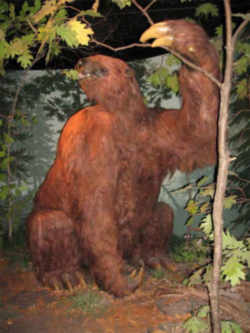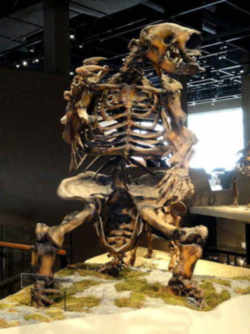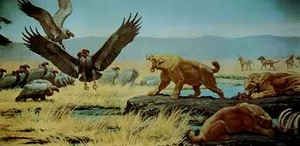
West Virginia Symbols
West Virginia State Fossil
Giant Ground Sloths

(Megalonyx jeffersonii)
Adopted in 2008
In 2008, the state legislature passed a resolution declaring Megalonyx jeffersonii the official state fossil of West Virginia.
Lawmakers, as well as scientists and historians, hope that the designation will promote greater study of and interest in geology, paleontology, and American and West Virginia history among students and other residents of the state.
Thanks to Delegate Mike Burdiss (Wyoming County) and Senator Roman Prezioso (Marion County), the State Legislature passed the resolution to designate Megalonyx jeffersonii the official State Fossil of West Virginia.
The legislation was written and proposed by Ray & Mary Ellen Garton from Barrackville, Hassan Amjad from Beckley, Robert Pyle and Dave Phillips from Morgantown.
West Virginia State Fossil: Giant Ground Sloths

Megalonyx (Greek, "great claw") is an extinct genus of giant ground sloths of the family Megalonychidae endemic to North America from the Hemphillian of the Late Miocene through to the Rancholabrean of the Pleistocene, living from ~10.3 Mya- 11,000 years ago, existing for approximately 10.289 million years. Type species, M. jeffersonii, measured about 3 m (9.8 ft) and weighted up to 1 ton.
Characteristics of the Megalonyx
Jefferson's ground sloth is one of the most unusual North American ice-age mammals. It is the largest known speciesof Megalonyx, and reaches the
size of an ox at 2.5 to 3 m (8 to 10 ft.) long. Its skull is short, broad and deep with a blunt muzzle. The teeth are peg-like, and space separates
the blunt, broad caniniforms (fang-like teeth) from the wider cheek teeth. It had plantigrade hind feet, the weight being borne on the sole rather
than the outside of the foot as in other ground sloths. Perhaps that feature, combined with thick hair, enabled this species to range farther north
than other North American ground sloths.
Ground sloths originated in South America and are distantly related to the living tree sloths of that continent. Jefferson's ground sloth first appeared
during the second-last glaciation, perhaps 200 000 years ago. The species lived in woodlands, probably browsing on leaves, twigs and perhaps nuts.
Its fossils are known from the eastern two-thirds of the United States and in western North America from central Mexico to Alaska, Yukon and Northwest
Territories. All of the Yukon specimens are relatively small, suggesting a last interglacial age (about 120 000 years ago). Information gathered from
the northernmost specimens implies that the species occupied a broad east-west range in northwestern North America during a warm phase of the Late
Pleistocene Epoch.
This species is of historical as well as paleontological significance: Thomas Jefferson's lecture on Megalonyx ("great claw") to the American
Philosophical Society in 1797 marked the beginning of vertebrate paleontology in North America. Appropriately, Megalonyx jeffersonii was named for
him, the third president of the United States.
West Virginia SENATE CONCURRENT RESOLUTION NO. 28
In 2008, the state legislature passed a resolution declaring Megalonyx jeffersonii the official state fossil of West Virginia.
(By Senators Barnes, Love, Fanning, White and Sypolt)
Designating the timber rattlesnake as West Virginia's state reptile and designating Megalonyx Jeffersonii as West Virginia's state fossil.
Whereas, The timber rattlesnake is an integral part of the history, culture and ecology of West Virginia and the United States; and
Whereas, The timber rattlesnake is present throughout West Virginia and its color and pattern is reminiscent of West Virginia's fauna and flora; and
Whereas, The timber rattlesnake is important to preserve as a predator and prey in West Virginia's ecology; and
Whereas, The timber rattlesnake kills mice and rats at no cost while cleaning up after itself; and
Whereas, The timber rattlesnake is a popular icon that does attract attention and, thereby, may enhance tourism; and
Whereas, Since no other state has adopted the timber rattlesnake as a state reptile, West Virginia can be the first and it would be a proud contribution
by the eighth grade class at Romney Middle School, from West Virginia's oldest county, in West Virginia's oldest town, to have been instrumental in
making the timber rattlesnake the state reptile of West Virginia; and
Whereas, No fossil has been designated as the official state fossil for the State of West Virginia; and
Whereas, Interest in fossils and paleontology has become increasingly widespread throughout the citizenry of this state, there currently being fossil,
rock and gem clubs already organized in the counties of Cabell, Harrison, Kanawha and Wood; and
Whereas, In 1797, President Thomas Jefferson obtained and described fossil bones from a limestone cave in what is now Monroe County; and
Whereas, These bones were again described by Casper Wistar in 1799 as the bones of a giant extinct ground sloth; and
Whereas, Wistar named the bones as a new species, Megalonyx Jeffersonnii, in honor of President Jefferson; and
Whereas, The bones are from the Ice Age or Pleistocene Epoch which lasted from 10,000 to 1.8 million years ago; and
Whereas, The designation of a state fossil would aid in the promotion of interest in geology, paleontology and history; and
Whereas, The bones afford an opportunity for special studies in American, state and natural history for the students of the state; and
Whereas, Thirty-nine of the 50 states have an official state fossil; therefore, be it
Resolved by the Legislature of West Virginia:
That the Legislature hereby designates the timber rattlesnake as West Virginia's state reptile and designates the fossil Megalonyx Jeffersonnii as
West Virginia's state fossil; and, be it
Further Resolved, That the Clerk of the Senate is hereby directed to forward copies of this resolution to the citizens and schools in the state.
Taxonomic Hierarchy: Giant Ground Sloths
Kingdom: AnimaliaPhylum: Chordata
Class: Mammalia
Superorder: Xenarthra
Order: Pilosa
Family: Megalonychidae (Gervais, 1855)
Subfamily: Megalonychinae
Genus: †Megalonyx (Harlan, 1825)
Species
†M. matthisi (Hirschfeld & Webb, 1963)
†M. wheatleyi (Cope, 1871)
†M. leptostomus (Cope, 1893)
†M. jeffersonii (Desmarest, 1822)

Some states that lack a "state fossil" have nevertheless singled out a fossil for formal designation such as a state dinosaur, rock, gem or stone.






